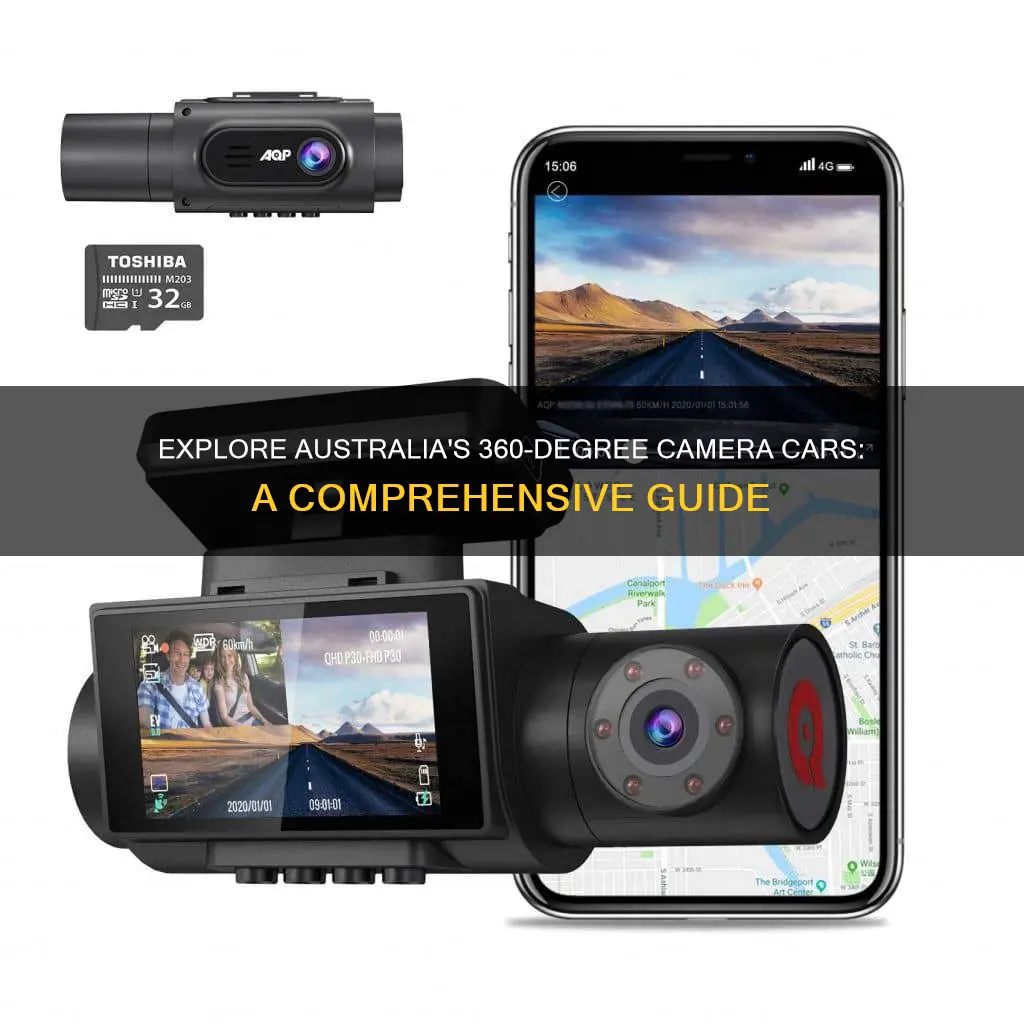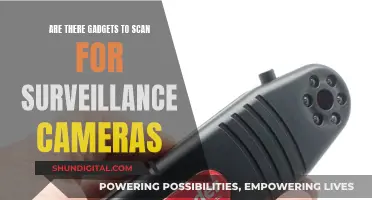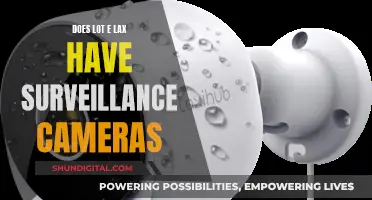
A 360-degree camera is one of the more impressive safety features available in newer vehicles. It is often referred to as a drone's-eye view or a bird's-eye view and is created by stitching together the camera information from around the car to generate a top-down render. This feature is especially useful when parking, as it helps to detect objects nearby, minimise blind spots and guide the driver with alignment lines.
Several cars in Australia offer a 360-degree camera, including the Nissan Qashqai, Hyundai Ioniq 5, Audi Q7, Haval Jolion, Volvo XC40, and Mazda3.
What You'll Learn
- Nissan Qashqai: A 360-degree camera, front and rear sensors, and a bird's-eye view help navigate tight spots
- Mazda 3: Four cameras provide a 360-degree view, minimising blind spots and potential dangers
- Audi Q7: A 360-degree camera, parking sensors, and multiple camera angles guide you through tricky situations
- Haval Jolion: The 360-degree camera features a bird's-eye view and a multi-view select 3D mode, aiding parking
- Volvo XC40: Four cameras combine to provide a bird's-eye view, with guiding lines to predict the car's angle

Nissan Qashqai: A 360-degree camera, front and rear sensors, and a bird's-eye view help navigate tight spots
The Nissan Qashqai is a compact crossover SUV designed and produced by the Japanese car manufacturer Nissan since 2006. The Qashqai is named after the Qashqai people, who live in mountainous Central and Southwestern Iran. The Qashqai has been available in Australia since 2014.
Nissan's Intelligent Around View Monitor system is a valuable feature for new car buyers to consider when looking to enhance their driving experience. This system uses a combination of cameras placed around the vehicle to provide a complete view of the car's surroundings, making parking and manoeuvring in tight spaces much easier. This feature is especially helpful for new drivers or those who lack confidence in their driving skills.
The Intelligent Around View Monitor system is available on various Nissan models and trim levels. The system uses four wide-angle cameras mounted on the front, each side mirror, and the rear of the vehicle, an image processing unit, and a central display unit. The cameras capture images, which are then displayed on the car's infotainment system, providing the driver with a clear, 360-degree view of the car's surroundings. The system also includes front and rear parking sensors, which provide audio and visual alerts to help guide the driver through tricky situations.
The Nissan Qashqai's 360-degree camera technology helps cut down on parking mistakes. The Around View Monitor (AVM) system gives the driver a comprehensive view, with four separate wide-angled cameras positioned strategically around the exterior of the car. Images are then fed into the Nissan Connect touch-screen monitor, allowing motorists to gauge their manoeuvring. Using the images as a reference point, drivers can confidently position their vehicles into tight spots without worrying about collisions.
Avoid Camera Tickets: Tips to Keep Your Record Clean
You may want to see also

Mazda 3: Four cameras provide a 360-degree view, minimising blind spots and potential dangers
The Mazda 3 is equipped with a 360-degree view monitor, providing a comprehensive display of the conditions around the car on the centre screen. This technology offers a bird's-eye view of the surroundings, enhancing spatial awareness and making parking and navigation easier. The system uses four cameras, one on each side of the vehicle, to create a seamless panoramic view, helping to minimise blind spots and avoid potential dangers.
The 360-degree view monitor offers multiple display options, including front, rear, side, and bird's-eye views. Each angle provides a unique perspective to assist in different driving scenarios. The front view aids in navigating traffic or obstacles, while the rear view ensures safe reversing and parking. The side views assist with lane changes and detecting nearby vehicles, and the bird's-eye view offers a comprehensive understanding of spatial relationships and potential hazards.
The system also includes front and rear parking sensors that detect the vehicle's proximity to obstacles and sound an alarm as the vehicle gets closer to them. This feature is especially useful when navigating tight spaces and makes the sometimes difficult task of parking less stressful.
The 360-degree view monitor enhances safety by providing real-time visuals of the surroundings, acting as an extra set of vigilant eyes. It also helps to develop a 360-degree awareness mindset, expanding perception beyond what's directly in front of the driver. This technology should be used in conjunction with traditional mirrors, creating a multi-faceted safety net that covers blind spots and enhances situational awareness.
The Mazda 3's 360-degree view monitor is part of the Vision Technology suite, which is now available to every grade of Mazda 3. This technology is designed to make every drive an effortless one, providing features such as driver monitoring, front cross-traffic alert, and cruising and traffic support.
Charging Up: Camera vs. Car
You may want to see also

Audi Q7: A 360-degree camera, parking sensors, and multiple camera angles guide you through tricky situations
The Audi Q7 is a large, luxury SUV that offers a range of advanced driver assistance systems, including a 360-degree camera system. This technology provides a comprehensive view of the vehicle's surroundings, making parking and manoeuvring in tight spaces much easier.
The 360-degree camera system in the Audi Q7 consists of multiple cameras positioned around the vehicle, including one in the front centre grille and another at the rear above the number plate. The system also incorporates ultrasonic sensors, which provide additional data on the car's immediate surroundings. When activated, the system displays different views on the Multi Media Interface (MMI) monitor, such as a virtual bird's-eye view and 180-degree images of the front and rear. These views are particularly useful when navigating through confusing exits or tight parking spots.
In addition to the 360-degree camera, the Audi Q7 offers other parking assistance features. The Park Assist system, for example, can automatically steer the vehicle into parallel or perpendicular parking spaces. It uses ultrasonic sensors located in the front and rear bumpers and on the sides to measure the size of parking spaces while driving past them. Once a suitable spot is found, the system handles the steering, while the driver controls the acceleration, braking, and gear shifting.
The Audi Q7 also includes a reversing camera, which is activated when the vehicle is in reverse or by pressing a button. This camera displays the zone behind the car on the MMI screen, along with calculated driving tracks based on the steering angle and auxiliary guide lines. These guide lines are especially helpful when parking in perpendicular spaces or when hitching trailers.
The 360-degree camera system and other parking assistance features in the Audi Q7 enhance the overall driving experience, providing confidence and peace of mind when navigating through challenging situations. The combination of advanced camera technology and sensor systems ensures that drivers have a clear understanding of their surroundings, making parking and manoeuvring more precise and safer.
The Ultimate Guide to Installing Camera Mods
You may want to see also

Haval Jolion: The 360-degree camera features a bird's-eye view and a multi-view select 3D mode, aiding parking
The Haval Jolion is an SUV that combines cutting-edge looks with innovative technology. One of its standout features is the 360-degree camera, which offers a bird's-eye view and a multi-view select 3D mode, making parking a breeze.
The 360-degree camera system in the Haval Jolion provides drivers with a comprehensive panoramic view of their surroundings. With this feature, drivers can easily navigate tight parking spots, narrow laneways, and busy city streets. The bird's-eye view gives a clear perspective of the car's position relative to surrounding objects, while the multi-view select 3D mode enhances spatial awareness and makes parking a less stressful experience.
The camera images are displayed on the high-resolution 12-inch touchscreen of the Haval Jolion's multimedia system. This large and detailed display ensures that drivers have a clear and uninterrupted view of their surroundings, aiding in parking and low-speed manoeuvres. The system's intuitive interface allows drivers to easily switch between different camera angles and views, providing a dynamic perspective of their vehicle and its surroundings.
In addition to the 360-degree camera, the Haval Jolion comes equipped with a range of other innovative safety features. These include Adaptive Cruise Control, which maintains the vehicle's speed and responds quickly to changes in road conditions, as well as Autonomous Emergency Braking and Collision Warning Sensors. The vehicle also offers Blind Spot Monitoring, Lane Keep Assist, and a Rear Parking Assist System, further enhancing the driver's awareness and safety.
The Haval Jolion's combination of style and technology extends beyond its camera and safety features. The SUV boasts a sleek and contemporary exterior design, with sweeping front grilles and dynamic rear lights that leave a lasting impression. The interior is just as impressive, with a driver-focused cockpit, ergonomically designed seats, and ample legroom and boot space for comfort during long journeys. The vehicle also offers a range of convenient tech features, such as wireless charging, Apple CarPlay, and a large-format multimedia touchscreen, making the Haval Jolion a smart choice for modern drivers.
Who Gets the Ticket? Speeding Camera Tickets Explained
You may want to see also

Volvo XC40: Four cameras combine to provide a bird's-eye view, with guiding lines to predict the car's angle
The Volvo XC40 is a highly advanced SUV with a unique 360-degree view feature. This innovative technology combines four cameras positioned around the vehicle's perimeter to provide a bird's-eye view of the car and its surroundings. This feature is incredibly useful when navigating tight parking spots, as it allows drivers to see all angles of the car and predict its trajectory accurately.
The XC40's 360-degree camera system offers a comprehensive view by stitching together video inputs from the front grille, door mirrors, and rear tailgate. This creates an overhead panorama that makes parking in confined spaces a breeze. The system also includes guiding lines that help drivers judge the angle of the car and determine if it can fit into tight spaces. This predictive capability ensures drivers can park with confidence and precision.
The Volvo XC40's 360-degree camera is an excellent example of how technology enhances driving experiences, especially in challenging situations like parking. This feature not only makes parking easier but also safer, reducing the risk of collisions with surrounding objects or other vehicles. It is a testament to Volvo's commitment to innovation and driver assistance technologies.
The XC40 stands out in the competitive SUV market by offering this advanced parking assistance system. With the ability to visually navigate parking spaces from multiple angles, drivers can make informed decisions and manoeuvre with ease. This feature is a valuable tool for drivers of all skill levels and reinforces Volvo's reputation for safety and technological prowess.
The 360-degree camera is just one of the many innovative features found in the Volvo XC40. Its inclusion highlights Volvo's dedication to improving driver convenience and safety through technology. By offering a comprehensive view of the vehicle's surroundings, Volvo has addressed a common challenge faced by drivers, making the XC40 an attractive choice for those seeking a feature-rich and technologically advanced SUV.
Speeding in NY: Camera Tickets and License Suspension Risks
You may want to see also
Frequently asked questions
Some cars with a 360-degree camera in Australia include the Nissan Qashqai, Hyundai IONIQ 5, Audi Q7, Haval Jolion, and Volvo XC40.
A 360-degree camera can provide a bird's-eye view of the car's surroundings, making it easier to navigate tight spaces and park. It can also help to minimise blind spots and improve safety.
A 360-degree camera system uses multiple cameras positioned around the car to capture footage from different angles. This footage is then stitched together to create a top-down view or a 3D model of the car and its surroundings.
Yes, there are aftermarket 360-degree camera systems available that can be installed on existing vehicles. However, it is recommended to consult a professional for proper installation.
The cost of a 360-degree camera system can vary depending on the car model and the specific features included. In some cases, it may be offered as an optional add-on for a certain price, while in others, it may be included as a standard feature in higher trim levels.







